Knygotyra ISSN 0204–2061 eISSN 2345-0053
2022, vol. 78, pp. 140–162 DOI: https://doi.org/10.15388/Knygotyra.2022.78.109
Expert Reception of The Limits to Growth: A Few Simple Tools for the Book Historian
Cheryl Knott
School of Information, University of Arizona
P.O. Box 192, Pearce, AZ 85625-0192 USA
E-mail: cherylknott@arizona.edu
Summary. In the early 1970s, a research team at the Massachusetts Institute of Technology used new methods of computer modelling to simulate global dynamic processes. The outcome of their work was a series of projections of the depletion of natural resources worldwide, with potentially dire consequences for the environment and the economy. Their report on their modelling and its projections was issued as a book in 1972, entitled The Limits to Growth. It created an immediate debate among scholars, policy makers, and other educated readers, and publications citing The Limits to Growth over its lifespan are voluminous. It continues to be cited 50 years after it was issued. The long citation period and the varied responses over time pose challenges for the book historian seeking to characterise the reception of the book. This article explores the ways in which book historians can use readily available citation analysis and visualisation tools to deepen understanding of a book’s reception beyond the qualitative methods typically used in the secondary literature. The Web of Science’s citation indexing and the HathiTrust collection’s full-text searching capability are used to identify articles and books that have cited or referred to The Limits to Growth. Examples of the visualisations generated from the search results in each are included as illustrations of simple, accessible tools that the lone book historian can use when the scale of his or her work does not require the kind of computational analytics created to parse big textual data in digital humanities projects.
Keywords: Citation analysis, The Limits to Growth, reception, Web of Science, environmental studies
Augimo ribų ekspertinis suvokimas: keletas paprastų įrankių knygos istorikui
Santrauka. Aštuntojo dešimtmečio pradžioje Masačusetso technologijos instituto tyrimų grupė ėmė taikyti naujus kompiuterinio modeliavimo metodus siekdama imituoti pasaulinius dinaminius procesus. Jų darbo rezultatas buvo nemažas skaičius prognozių apie gamtos išteklių išeikvojimą visame pasaulyje. Jos skelbė baisius padarinius aplinkai ir ekonomikai. Ataskaita apie modeliavimą ir jo prognozes buvo pristatyta 1972 m. išleistoje knygoje Augimo ribos (angl. The Limits to Growth). Tai iš karto sukėlė diskusijas tarp mokslininkų, politikos formuotojų ir kitų išsilavinusių skaitytojų, o publikacijų, kuriose cituojama knyga Augimo ribos per visą jos gyvavimo laikotarpį, yra daugybė. Ji ir toliau cituojama praėjus 50 metų nuo išleidimo. Ilgas citavimo laikotarpis ir įvairūs atsakymai laikui bėgant kelia iššūkių knygos istorikui, siekiančiam apibūdinti knygos suvokimą (recepciją). Šiame straipsnyje nagrinėjama, kaip knygos istorikai gali naudoti lengvai prieinamas citatų analizės ir vizualizavimo priemones, siekdami pagilinti supratimą apie knygą, o ne kokybinius metodus, paprastai taikomus antriniuose šaltiniuose. „Web of Science“ citatų rodyklės ir „HathiTrust“ viso teksto paieškos kolekcijos yra naudojamos identifikuoti straipsnius ir knygas, kuriose cituojama arba minima knyga Augimo ribos. Vizualizacijos pavyzdžiai, sugeneruoti iš kiekvieno paieškos rezultato, pateikiami kaip paprastų, prieinamų įrankių iliustracijos, kurias gali naudoti savarankiškas knygos istorikas, kai jo darbo mastas nereikalauja skaičiavimo analizės, skirtos dideliems tekstiniams duomenims analizuoti skaitmeninių humanitarinių mokslų projektuose.
Reikšminiai žodžiai: citavimo analizė, Augimo ribos, supratimas, „Web of Science“, aplinkos apsaugos tyrimai.
Received: 2021 11 07. Accepted: 2022 03 23
Copyright © 2022 Cheryl Knott. Published by Vilnius University Press. This is an Open Access journal distributed under the terms of the Creative Commons Attribution Licence, which permits unrestricted use, distribution, and reproduction in any medium, provided the original author and source are credited.
For the historian investigating the reception of a nonfiction book, citation data provides one form of evidence. Each author of a publication that cites the book signals their awareness of it; they count themselves among its readership. Traditional citation indexing tools are useful for identifying who is citing whom, and digital full-text books and articles offer additional ways to identify references to others’ works. For studying expert reception of nonfiction books – the ways in which scholars and other knowledgeable readers interpret and use a text – citation and full-text searching are useful methods. Although not designed specifically for historians of the book, citation indexing and digital full text can support studies of reception by helping the researcher compile, analyse, and visualise data about a book’s network of users and patterns of citation over time.
Such an approach can deepen understanding of the impact of a widely distributed and highly controversial book published in 1972, The Limits to Growth. The authors generated and interpreted a collection of computerised simulations indicating that unmitigated population growth and natural resource depletion would lead to global collapse within one hundred years.1 Scholars, some of them in disciplines that did not exist when the book was published, continue to cite the book decades after its first appearance. The Limits to Growth can serve as a case study in the use of citation indexing and full-text searching to quantify and visualise reception using readily available tools. Although not the only possible way to understand a book’s reception, treating citations and references to a book as reception data can offer historians an additional tool for discerning a book’s reach across disciplines and over time.
As other work in this issue demonstrates, historians of the book, literary scholars, and digital humanists are creating methods and tools for parsing the big data of published and unpublished expression in digital form. Interdisciplinary teams bring together researchers and practitioners with knowledge of the scholarly literature, skills in digitisation and coding, and expertise in natural language processing and data visualisation. From the earliest of these efforts have come projects whose promise is now being realised.
But even the historian who works alone, with neither research grants nor coding skills, can take advantage of readily available analytic tools useful for the kinds of data that books and other forms of written expression generate and contain. The Web of Science suite of citation indexes to scholarly journals and the HathiTrust collection of digitised books make it possible not only to identify works referring to The Limits to Growth but also to create visualisations of the data. Such tools make documenting the ongoing reception of a fifty-year-old book a somewhat less daunting project than it otherwise would be. What’s clear is that The Limits to Growth had an immediate and well-documented impact. Less studied is the way in which its methods and interpretations have infiltrated the thinking of a wide variety of people.
The Limits to Growth
At the United Nations Climate Action Summit in the fall of 2019, environmental activist Greta Thunberg criticised an audience of politicians and policy makers for their inadequate response to the climate emergency. Thunberg told them it was time to give up their ‘fairytales of eternal economic growth’.2 Although few of the climate summit attendees may have known about or read The Limits to Growth, issued three decades before Thunberg was born, the assertion that eternal economic growth is a fairy tale was its key point, and the one that made it a controversial work.
The book, issued in paperback in multiple languages and distributed worldwide, was intended for a readership of policy makers and an educated public whose interest in environmental issues had been piqued with Rachel Carson’s 1962 bestseller Silent Spring. In the late 1960s, Aurelio Peccei, an Italian business executive in the automobile industry, and several of his friends founded the Club of Rome, a loosely organized multinational group of industrialists, government officials, and scholars who were worried about the planet’s future, what they called ‘the predicament of mankind’.3
The origin of The Limits to Growth can be traced to Peccei’s introduction to Jay Wright Forrester, a faculty member in the school of business at the Massachusetts Institute of Technology (MIT). During World War II, Forrester had helped engineer system feedback devices to improve pilot and airplane performance. Afterwards, during the Cold War, he worked in a lab designing computer components for use in an air-defence system the U.S. military was creating. In the late 1950s, he joined the MIT faculty and began to apply his knowledge of systems and computers to creating mathematical models of dynamic business processes. He then moved on to apply his methods to cities.4 When he and Peccei met in Italy at a conference on urban problems in 1968, their talk turned to global problems and Forrester saw an opportunity to use his methods on the largest scale possible. He sketched out a model for the Club of Rome and subsequently described it in detail in his 1971 book World Dynamics.5
Forrester then turned the project over to his junior colleague at MIT, Dennis Meadows who, with funding arranged by Peccei, created a research team to develop system dynamics methods further by using real data to model population, energy, natural resources, agricultural production, and pollution. Seeking to have the greatest possible impact, Peccei pushed the research team to finish their report in time for the first United Nations Conference on the Human Environment, scheduled for June 1972 in Stockholm. He worked closely with Donella (‘Dana’) Meadows, who had recently completed a PhD at Harvard and who had joined her husband’s research team at MIT. Her facility with clear language helped Club of Rome members understand the work as the team made progress. The team met Peccei’s deadline by issuing The Limits to Growth, with Dana Meadows as first author. It was comprehensible to policy makers and other educated readers, but the type of technical documentation that scholars would expect was absent.6
Two years later, the research team did publish the highly technical Dynamics of Growth in a Finite World, but by then the controversy over The Limits to Growth had already spawned scholarly work that in some cases built on the early attempts to model Earth’s systems and in other cases refuted the need for limits. Scholars of economics and the nascent field of environmental studies were especially engaged in grappling with the concepts and methods involved in modelling such a complex and dynamic system. Historian Thomas Robertson, in his book The Malthusian Moment, traces the alarm about overpopulation and its impact to the late 1960s with such publications as Paul and Anne Ehrlich’s The Population Bomb (published in 1968). Despite the furor over population growth and the books that fuelled the furor, Robertson asserts that ‘Few books ... were more influential than The Limits to Growth’.7
One gauge of its influence is the reaction against it. Newspapers and magazines ran stories about it and scholarly journals published reviews and research articles. In 1972, the use of computers for modelling complex processes and the conceptualisation of Earth as one big system were new. Their novelty alone invited scepticism. That the research team used those methods and concepts to project future outcomes that could be avoided only by reining in the world’s relentless drive for eternal economic growth meant that economists in particular would take exception to the work.
Some experts felt so strongly that the Meadows team was wrong that they crossed the boundary between the scholarly and the popular by publishing scathing critiques in newspapers and magazines to make sure non-expert readers heard their message. For example, three economists, from Columbia University, the Columbia Law School, and Harvard, published a review of The Limits to Growth and World Dynamics in the New York Times. About Limits, they wrote that it was ‘an empty and misleading work’ exemplifying ‘the oldest maxim of computer science: Garbage In, Garbage Out’.8
Ugo Bardi, in his 2011 book Limits to Growth Revisited, notes that the economists’ review in the New York Times misinterpreted some of the data presented in Limits as predictions when the authors intended them merely as illustrations. Bardi points out that this early misinterpretation in a clearly hostile review would be revived periodically by journalists as well as scholars. In his overview of the book’s reception trajectory, Bardi identifies other critical publications that influenced perceptions over time. The critiques he highlights are from scholars and journalists and written for specialists and non-specialist educated readers.9
For example, a damaging scholarly critique came from William Nordhaus, a Yale University economist, whose 1973 essay focussed on the flaws in Jay Forrester’s World Dynamics, thus damning Limits by association. By the 1990s, according to Bardi, hardly anyone considered The Limits to Growth a worthwhile project, in large part because of journalist Ronald Bailey’s article ‘Dr. Doom’ in a 1989 issue of the business magazine Forbes and his subsequent book Eco-Scam: The False Prophets of Ecological Apocalypse.10
Bardi traces Bailey’s negativity back to the New York Times review from 1972 and forward as it seeped into popular and scholarly assessments.
Bardi identifies a later turning point in the reception trajectory, exemplified by a handful of articles reappraising the book in the first decade of the 21st century. In 2008, Graham Turner, an applied physicist specialising in sustainability and systems analysis, published ‘A comparison of The Limits to Growth with 30 years of reality’, which found the projected consequences of the ‘business-as-usual’ scenario from 1972 to be on track.11 The ScienceDirect database, where the full text of Turner’s article is accessible, shows 224 citations of the work, as of autumn 2021. Turner also spread his message in the popular press, publishing, with coauthor Cathy Alexander, an essay in The Guardian in 2014 titled ‘Limits to Growth was right. New research shows we’re nearing collapse’.12
Although Bardi is a professor of physical chemistry rather than book history, his use of several important publications to give the broad outlines of a complicated reception trajectory is a common approach. Historians often rely on high-profile reviews and critiques as gauges of a nonfiction book’s reception and impact. Reviews and critiques by respected scholars influence the fortunes of a book and its authors and can reveal the history of an idea and its development. They form the basis for the historian’s story about the book. Such an approach, highlighting key examples of reception, is useful for understanding the ways in which influential media and knowledgeable experts interpreted the text. As with all sources, the historian must decide which to use and how to use them to construct a story as an argument about the past. Comments from certain kinds of readers – those who write reviews and critiques – provide examples and evidence of reception. Relying on the most influential reviews and critiques makes sense because of their influence; it matters what experts say about a blockbuster like The Limits to Growth.
When the book historian is lucky, the author’s papers, if they are available, include a folder or scrapbook of clippings harvested from newspapers and magazines that may provide additional perspectives beyond those of influential scholars. As sources, the reviews and articles that appear in scholarly journals, popular magazines, and newspapers have the advantage of specificity: the reviewer’s name and credentials, their chief points about the book, the timing of their review in relation to the book’s publication date, and the publication venue. They can be mined for convincing anecdotal evidence of reception by expert and non-expert alike. A history highlighting the influential and the specific can be augmented with the kind of comprehensive representation of a book’s reception that citation indexing and digital full text allow. Citation analysis and data visualisation can help add a broader context and perspective. Against a backdrop of quantitative citation data, the historian’s choice and use of qualitative sources become more obvious, more nuanced, and perhaps more persuasive.
Citation Indexing
While library catalogues and commercially produced indexes have made it possible to find books and articles by subject, they have not been capable of helping their users easily discover the network of researchers working on a topic or the set of books and articles linked to each other by their references. Since such researchers and publications are connected by a common topic, being able to identify them through their links to each other is another way to find information resources on a subject. Citing indexing allows just that kind of discovery. The innovation of citation indexing is the ability to find publications via the references to them by other authors. Traditional indexing of books and articles to indicate their subject matter had two main weaknesses: the mismatch between the terminology, the controlled vocabulary, used by the indexer and the natural language used by the information seeker, and the inability to track down the origination of a new idea or method and its trajectory over time. Citation searching offered a different path to relevant research by making the author and their work, rather than the subject of the work, the access point into the scholarly literature.13
As originally conceived by Eugene Garfield in the 1950s, a citation index makes it possible for scientists to avoid citing an out-of-date or erroneous article by finding the later papers that cite it. The citing papers might update the original article, correct errors that appeared in it, and/or extend the author’s methods and interpretation. A scholar could use a current work’s citations to track earlier and earlier works to finally arrive at the one expressing a new idea or method that was taken up and developed further in subsequent works. A scholar could take the reverse route, searching for the subsequent works that cited a book or article. Furthermore, Garfield asserted, a scientist could generate a list of all the articles citing their work, thus building a case for their impact on their field of endeavour. Such an exercise to track use of one’s ideas, methods, and findings might deepen a scientist’s understanding of their own work and introduce them to others in the network of researchers on the same or related topics.14
Garfield’s idea was realised in 1964 with the publication of the Science Citation Index, a bibliographic tool that made a new – though cumbersome – form of access to scholarly literature available to researchers interested in the structure of publishing and the network of scholars in their field. The initial issue included a source index listing articles published in 613 journals in 1961 and a separate cited reference index listing more than one million items cited in those journal articles. In the 1970s, the Arts & Humanities Citation Index and the Social Sciences Citation Index became available and their source indexes included books as well as journal articles. In 1997, the three citation indexes became the core collection of the Web of Science digital database.15
While citation indexing was first conceptualised and implemented to serve scientists in need of new ways to filter the ever-increasing research output of the twentieth century, the availability of citing and cited references led to other uses of the data. For example, a team of Danish management scholars used Web of Science to identify articles using four different terms related to sustainability and the meanings ascribed to each of the terms in the articles they identified. The team then used what they call ‘bibliometric analysis’ to uncover the network of scholars who used the terms in the same way and the journals that most often published their work. This method allowed the team to take an approach, rooted in the differing meanings of commonly used terms, that acknowledged the tensions within the sustainability field.16
Other uses have generated controversy, however. Both a journal’s and an author’s ‘impact’ could be calculated based on the number of times their articles were cited. Librarians have used journal impact factors to help them make decisions about starting subscriptions or cancelling them, while research faculty have used them to decide where to submit their manuscripts. Authors’ impact based on the number of times their work has been cited can help them get research grants, promotion and tenure, and other forms of recognition. In the 1990s, Garfield himself used citation indexing data to identify the most-cited science and social science articles between from 1945 to 1992, calling them ‘citation classics’.17
Critics of the use of citation indexing to quantify impact and make judgements based on the numbers point out that citation is a practice that reflects disciplinary cultures, biases, career ambitions, and other factors not strictly related to the quality of the published work.18 The work of scientists and other scholars builds on work already published and on the ongoing work of colleagues and other researchers. Many of the people and much of the work that inspires and influences scholars may be left uncited in their publications as they make strategic decisions about the nature of the influence and the relative need to cite it. The absence of a citation may be just as telling as the presence of one, but that cannot be quantified, or even documented, using a citation index.19 Despite a substantial body of research identifying the flaws in the design and application of citation metrics, various calculations of impact continue to be taken into consideration by promotion committees and funding agencies.20
Despite the critiques of some of the ways citation indexing has been used, it remains a potentially powerful method for book historians. It can help those attempting to construct a network of authors and publications related by their methods and topics. It makes it possible to identify a greater sweep of publications citing a book, not just the most influential or easily identified ones. Citation indexing cannot reveal all of the works that cited, or used without citing, The Limits to Growth, but it can identify the large number of citing articles published in the thousands of journals indexed in the Web of Science. The scope of citations can be studied and even quantified without resorting to an ‘impact factor’ calculation. As Burrows and Nurmikko-Fuller have noted, historical bibliometrics can uncover new insights and raise new questions about a book’s trajectory across space and time.21
A cited reference search in the Web of Science collection for meadows in the cited author index, limits to growth in the cited title index, and 1972 as the publication year of the cited item retrieves results indicating that the book has been cited 3,785 times since its publication, at least among the bibliographic items indexed in the Web of Science. The Web of Science system can display a bar graph or tree map showing the top ten disciplines represented in the citations. As figures 1 and 2 show, the bar graph provides an at-a-glance visualisation, while the tree map includes the number of citations in each disciplinary category. The categories are based on the disciplines covered by the journals.
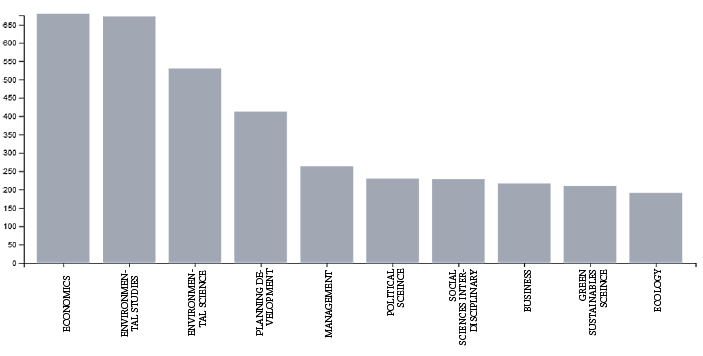
Figure 1. Web of Science bar graph of scholarly disciplines of journals publishing 3,785 articles citing the 1972 edition of The Limits to Growth
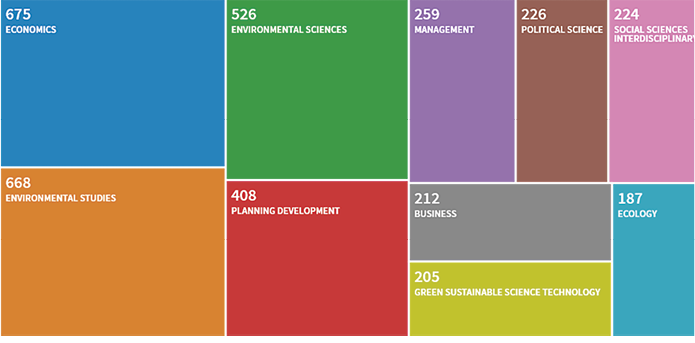
Figure 2. Web of Science tree map showing numbers of articles citing the 1972 edition of The Limits to Growth, categorised by journal subject coverage.
Since any bibliographic database is limited by the quantity and quality of the metadata representing its indexed items, the bar graph and tree map tell us as much about the categories used in Web of Science as they do about the disciplines where The Limits to Growth has been most discussed. It is not readily apparent what demarcates management from business or environmental studies from ecology, for example. Even so, it is clear that researchers in economics and the related fields of business, planning, and management form one big category of readers. Given the immediate outcry against the book by economists and the Meadows team’s affiliation with the MIT business school, it is not surprising that so many of the results are in fields related to economics and business. The citing articles in environmental sciences/studies, sustainable technologies, and ecology represent another sizeable readership. With the strong presence of results from the environmental disciplines, Aurelio Peccei and the Club of Rome were obviously successful at linking the book to the concerns apparent during and after the 1972 U.N. Conference on the Human Environment. While the categories labelled interdisciplinary social sciences and political science represent a smaller number of citing articles in the Web of Science results, all of the categories taken together suggest a broad cross-disciplinary engagement with Limits.
In addition to having built-in visualisation tools, Web of Science makes it easy to download citations that can then be uploaded into an Excel spreadsheet for further analysis. Given Bardi’s assertion that specific published responses to Limits served as turning points in its trajectory, a simple count of citations in five-year intervals can provide a visualisation to confirm or perhaps complicate this idea. From the spreadsheet containing the 3,785 citing articles downloaded from Web of Science, a new spreadsheet was created with the five-year time intervals in the first column and their respective totals in the second column. The Excel chart-generating feature was used to create a visualisation of the data, as shown in figure 3. There does appear to be less interest in the book in the 1980s and 1990s, as Bardi stated, evidenced by fewer articles citing it during that time period. And interest does increase after Turner’s favorable thirty-year reassessment, again, as Bardi stated. In broad terms, the trend of the numbers seems to correspond with Bardi’s assertions about the impact of several key publications.
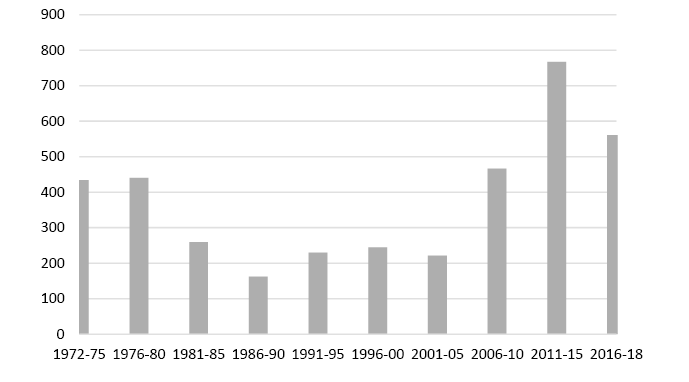
Figure 3. Number of articles citing the 1972 edition of The Limits to Growth, in five-year increments. Note: first increment is four years and the last is three years. N=3,785
The weakness in quantifying citations this way, of course, is the lack of data regarding how the cited item is discussed. Is the citing article positive, negative, or neutral regarding The Limits to Growth? For that, it’s necessary to look at each of the 3,785 citing articles. As a preliminary attempt, a spreadsheet was created containing 500 citing items published from 1973 to 2019 in journals in the environmental (rather than economic) fields. Each of the 490 articles that were available as full text was inspected to determine if the reference to Limits was positive, negative, or neutral. Positive and negative are relatively obvious determinations to make from reading the passages about the book in the context of the article as a whole. Articles were scored as neutral if the authors only mentioned the existence of the work or made brief factual comments about it. Of the 490 articles, only 24 were judged to be negative, 64 were considered positive, and 402 were neutral.
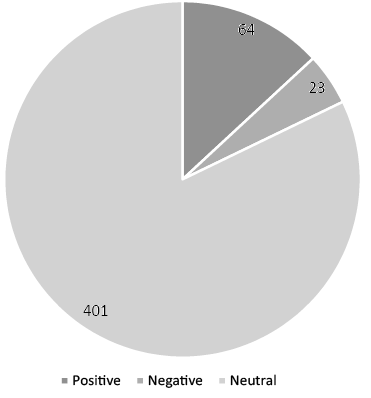
Figure 4. Positive, negative, and neutral mentions of The Limits to Growth in citing articles, 1973–2019. N=490. Source: Web of Science
The overwhelmingly neutral references to The Limits to Growth depicted in figure 4 are surprising, given how controversial the book has been and how uneven its citation trajectory has been. Since scoring as neutral meant that the book was only mentioned, this suggests that The Limits to Growth has become a book that authors need to cite to signal their awareness of it as a founding work, at least in environmental studies. Further research is needed to find out whether this sort of evaluation in the set of economics and business publications shows a different result.
Within environmental studies, the data can show which of the journals have cited Limits most frequently, as seen in figure 5. The Web of Science tree map indicated that economics and environmental studies and their related fields were the two broad disciplines whose journals most often published articles citing The Limits to Growth. At the intersection of these two disciplines is the most-citing journal in the set being examined here, Ecological Economics. The earliest citations in the set do not include articles from Ecological Economics because the journal was not founded until 1989. The introductory editorial in the inaugural issue cites two publications as launching and then escalating a debate over the continuing availability of energy and resources: Scarcity and Growth, published in 1963 by Resources for the Future, and The Limits to Growth.22 The book helped create a new field of interdisciplinary scholarship complete with its own journal, Ecological Economics. This is an example of one of the standard uses of historical bibliometrics, to document, as Jean-Pierre V. M. Hérubel has put it, ‘a more complete picture of disciplinary formation and evolution.’23 In the context of this study, however, it may suggest that the formation of a new discipline can itself be interpreted as a form of expert reception.
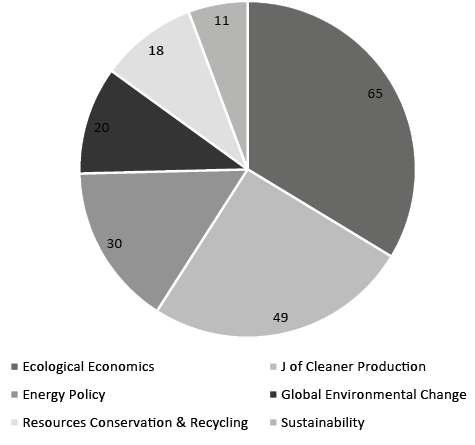
Figure 5. Journals with more than 10 articles citing The Limits to Growth and the number of their citing articles. Source: Web of Science
A study of the 77 books that were cited at least 15 times in Ecological Economics between 1994 and 2003 found that The Limits to Growth, cited in 26 articles, ranked 28th. During the same period, it ranked 3rd in the number of Web of Science citations with 2,417 articles citing it across a wide range of disciplines. With an average of 75.5 citations per year, the study’s authors concluded, the book is a ‘mega-classic’.24 A follow-up study indicated that there were even more citations to Limits in Ecological Economics from 2004 to 2014: 59 for the 11-year period compared to 26 for the earlier ten-year period.25
Digitised Books
The many neutral citations to the book can be interpreted as reinforcing its stature as a ‘mega-classic’. It has become a book that must be cited. But it’s also perhaps a book whose ideas and methods have become assimilated into disciplinary knowledge about systems analysis, dynamic modelling, and environmental issues – in other words, a book that, at least in some contexts, no longer needs to be cited as such. A glimpse of this as another kind of indicator of the book’s impact can be seen by using the n-gram viewer for Google Books. The search system is programmed to differentiate between upper- and lower-case letters, making it possible to search the book title, with its initial letters capitalised, and the phrase, entirely in lower case. As the n-gram viewer shows, in figure 6, the phrase has entered the lexicon and is used in books whose authors are not also citing the book.
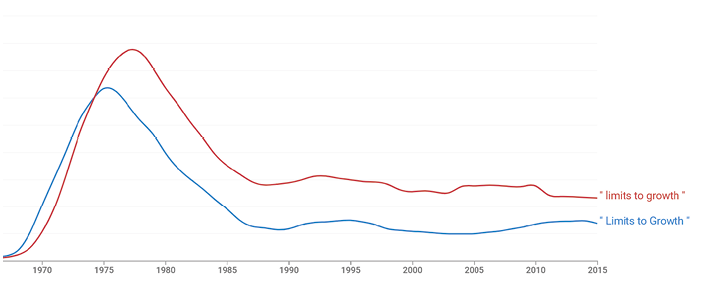
Figure 6. Google Books n-gram viewer graph of upper-case and lower-case results
Collections of digitised books comprise an enormous data source that can offer additional information about a book’s reception beyond the scholarly articles indexed in Web of Science. In the early years of the twenty-first century, tens of millions of the items now indexed in Google Books were digitised in American university research libraries. Although Google Books offers an advanced search form with options for finding books by author, title, ISBN, and other elements, its search and display functions are designed for non-researcher readers. In essence, ‘the world’s most comprehensive index of full-text books’, as the search page says, is oriented toward helping users find books they want to buy from a bookstore or from Google Play or borrow from a library.
More helpful for the book historian is the HathiTrust collection, described as ‘the largest set of digitized books managed by academic and research libraries — under the aims of scholarly, not corporate, interests’.26 HathiTrust is a consortium of member libraries; many of the libraries participated in the original Google Books digitisation project and their digitised books are included in the HathiTrust catalogue along with many other items. The HathiTrust Research Center provides access to the entire corpus and to tools and services related to computational analysis.27
For the book historian interested in simple tools, the collection search capabilities, results display, and filters can be useful.
A search of the HathiTrust collection for limits to growth as a phrase in the full-text retrieved 22,215 results for books and many results for other types of items (see figure 7). On the results page are filters for refining the results, but they are useful beyond that function. The filters are drawn from the metadata given on the full bibliographic records in the catalogue. The format filter indicates the number of books, serials, journals, and so on that are in the catalogue and that have the phrase somewhere in their full text. The subject filter is similar to the Web of Science tree map in that it shows the broad subjects of the works and the number tagged with those subject terms. As with the tree map, the greatest number of results for the phrase limits to growth are in the fields related to the environment and the economy (see figure 8).
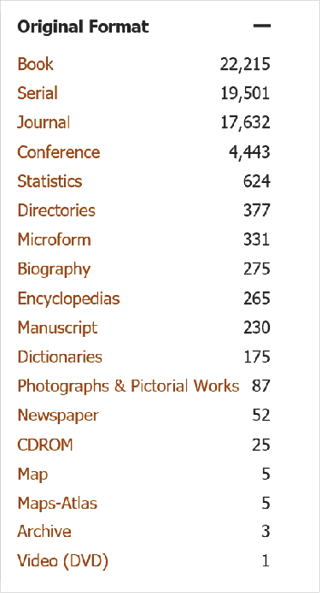
Figure 7. Format filters for the phrase limits to growth search results in the HathiTrust catalogue

Figure 8. Subject filters for the phrase limits to growth search results in the HathiTrust catalogue
The year-of-publication filter lists the number of publications for each year of the search results. At a glance, the researcher gets a sense of the relative age of the relevant works in the catalogue. Even better, the researcher can create a two-column spreadsheet of years and numbers and generate a line graph (figure 9) to compare to the lower-case limits to growth phrase depicted on the Google n-gram view.
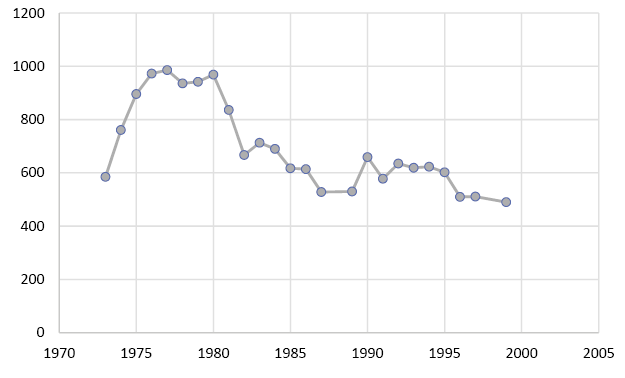
Figure 9. Books with phrase limits to growth 1972–1999. N=22,215. Source: HathiTrust collection
Broadly speaking, both lines trace an expected trajectory, with a spike of uses of the phrase soon after the publication of the book and gradual lessening of uses as the decades pass. Since the HathiTrust search system does not distinguish between upper- and lower-case, it is possible to calculate only a rough estimate of the number of mentions of The Limits to Growth itself. A search for the phrase limits to growth and meadows and 1972 in the full-text items yields 13,870 results. Subtracted from the 22,215 results for the phrase rather than the title gives 8,345 that use the phrase without mentioning meadows or 1972, which suggests that in those cases the phrase was used without the book being invoked.
This kind of searching is a workaround for collections that do not include citation indexing. These are mentions, not necessarily citations. As with the Web of Science preliminary look at the context to gauge whether authors were positive, negative, or neutral in their references to the book, it is possible to look at each of the books retrieved in the HathiTrust search to make the same kind of determination. For the approximately 2,000 whose full text is viewable – most of them U.S. government documents in the public domain – it would be relatively easy and quick to check. For the remaining 20,000 or so volumes, however, it would be difficult and time-consuming to get access to the full text of each one to inspect it for its author’s attitude toward Limits. With such big data, it would be necessary to turn to computational methods if the historian judged the resulting outcome necessary to their project’s purpose. To pose it as a question: would the argument the historian is trying to craft be convincing without the data from 20,000 books?
Conclusion
In the age of big data, the contents of digital articles and books constitute a corpus ripe for computational analysis. The question is: when does it make sense to move on from simple, readily available tools that are quickly mastered and easily applied? The size of the results for the search in the HathiTrust catalogue points to scale as a criterion on which to base such a decision. Indeed, it is the scale – the bigness – of the available data that has been one of the drivers for development of computational methods such as text and data mining using natural language processing and other artificial intelligence methods. But it is difficult to find a workable definition of big data, particularly in the bibliographic realm, or guidelines for when it is best – most efficient, most productive, most generative of insights – to employ or even invent methods for automated processing. At some point, the individual historian is overwhelmed by the magnitude of the texts available, and the data outstrips the spreadsheet’s capacity for storage and display.
The example where almost 500 articles were inspected by one individual to judge whether their references to Limits were positive, negative, or neutral raises questions. How many more sets of 500 is the individual able and willing to inspect? Was the individual consistent in her judgements? Could these judgements be systematised so that a computer could learn to make them? How long would it take to teach the computer how to make the judgements? How many people would have to be involved in designing, coding, testing, and tweaking the computer’s performance? Where would the funding come from and how much effort would be needed to write a successful proposal, manage the project, and submit the required reports? How much time would elapse before a research article could be submitted for publication?
Underlying all of these questions is a concern about the opportunity costs associated with such a project: what else could have been accomplished had a big data digital humanities project not been undertaken, and what questions would remain unanswered? These two questions, unanswerable in the abstract, are why scale is so important to figure out. Digital humanities projects to enable analysis of millions of pages of text require huge investments of time, energy, and expertise. And while scale may ultimately be the determining factor, it’s also important to take the project’s purpose into account. The immediate purpose in this case study was to understand how using simple, readily available tools can deepen understanding of the ways in which experts responded to The Limits to Growth over time. But this small case study is part of a much larger, longer-term project.
After fifty years, researchers continue to adapt the system dynamics and computer modelling methods introduced in the first edition of The Limits to Growth. Even though the original methods are out of date, the book continues to be cited. It was a seminal, if flawed, work that inspired new research in several different disciplines, some of them spawned since its publication. Underlying the book’s long, complicated trajectory are stories of scholarly practices, policy making, and reader response. Beyond the immediate case study lies a larger purpose: to deepen understanding, not only by adding some simple quantification and visualisation to the qualitative accounts of reception in the secondary literature, but also by finding new questions to ask to help reveal those stories. As the work in this volume shows, finding new questions and new ways to ask them has been a major strength of large-scale digital humanities projects. And the book historian working alone, without coding skills or grant funding, can continue to elucidate a book’s expert reception by learning from the publications that come out of digital humanities projects and adapting their own methods and interpretations using the available tools.
Reference list
BARDI, Ugo. The Limits to Growth Revisited. New York: Springer, 2011. 119 p. ISBN 9781-4419-9415-8.
BARNES, Cameron. The h-index Debate: An Introduction for Librarians. The Journal of Academic Librarianship, 2017, vol. 43, p. 487–494. ISSN 0099-1333.
BORNMANN, Lutz, and DANIEL, Hans-Dieter. What do Citation Counts Measure? A Review of Studies on Citing Behavior. Journal of Documentation, 2008, vol. 64, p. 45–80. ISSN 0022-0418.
BURROWS, Simon, and NURMIKKO-FULLER, Terhi. Charting Cultural History Through Historical Bibliometric Research: Methods; Concepts; Challenges: Results. In SCHUSTER, Kristen, and DUNN, Stuart, (eds.). Routledge International Handbook of Research Methods in Digital Humanities. Taylor & Francis Group, 2020, p. 109-124. ISBN 9781-1383-6302-1
CONSTANZA, Robert. What is Ecological Economics? Ecological Economics, 1989, vol. 1, p. 1–7. ISSN 9821-8009.
CONSTANZA, Robert, et al. Influential Publications in Ecological Economics: A Citation Analysis. Ecological Economics, 2004, vol. 50, p. 261–292. ISSN 9821-8009.
CONSTANZA, Robert, et al. Influential Publications in Ecological Economics Revisited. Ecological Economics, 2016, vol. 123, p. 68–76. ISSN 9821-8009.
ELICHIRIGOITY, Fernando. Planet Management: Limits to Growth, Computer Simulation, and the Emergence of Global Spaces. Evanston, IL: Northwestern University Press, 1999. 131 p. ISBN 0-8101-1588-3.
FORRESTER, Jay W. From the Ranch to System Dynamics: An Autobiography. In BEDEIAN, Arthur G. (ed.). Management Laureates: A Collection of Autobiographical Essays, vol. 1. Greenwich, CT: JAI Press, 1992, p. 363–386. Access through Internet: http://gu.friends-partners.org/Peace%20Gaming/System%20Dynamics/Forrester’s%20papers/Forrester-Ranch.html
GARFIELD, Eugene. Citation Indexes for Retrieval and Research Evaluation. Consensus Conference on the Theory and Practice of Research Assessment, 1996, vol. 7, n.p. Access through Internet: http://www.garfield.library.upenn.edu/papers/ciretreseval-capri.html
GARFIELD, Eugene. Citation Indexes for Science: A New Dimension in Documentation through Association of Ideas. Science, 1955, vol. 122, p. 108–111. ISSN 0036-8075. Access through Internet: http://www.garfield.library.upenn.edu/papers/science_v122v3159p108y1955.html
HathiTrust. Access through Internet: https://www.hathitrust.org/.
HAUPTMAN, Robert. Documentation: A History and Critique of Attribution, Commentary, Glosses, Marginalia, Notes, Bibliographies, Works-Cited Lists, and Citation Indexing and Analysis. Jefferson, NC: McFarland & Co., 2008, 229 p. ISBN 978-0-7864-3333-9.
HERUBEL, Jean-Pierre V. M. Historical Bibliometrics: Its Purpose and Significance to the History of Disciplines. Libraries & Culture, 1999, vol. 34, p. 380–388. ISSN 1534-7591.
LANE, David C., and STERMAN, John D. Jay Wright Forrester. In ASSAD, Arjang A. and GASS, Saul I. (eds.). Profiles in Operations Research, p. 363–386. Boston: Springer, 2011, p. 363–386.
LARIVIERE, V. and SUGIMOTO, C.R. The Journal Impact Factor: A Brief History, Critique, and Discussion of Adverse Effects. In GLANZEL, W.; MOED, H.F.; SCHMOCH, U.; and THELWALL, M., (eds.). Springer Handbook of Science and Technology Indicators. Springer, Cham, 2019, p. 3–24. ISBN 3-030-02511-X.
MACROBERTS, Michael H. and MACROBERTS, Barbara R. The Mismeasure of Science: Citation Analysis, Journal of the Association for Information Science and Technology, 2018, vol. 69, p. 475–476. ISSN: 2330-1643.
MEADOWS, Donella H. The History and Conclusions of The Limits to Growth. System Dynamics Review, 2007, vol. 23, p. 191–197. ISSN: 0883-7066.
MEADOWS, Donella H., et al. The Limits to Growth. New York: Universe Books, 1972. 205 p. ISBN 0876631650.
PASSELL, Peter; ROBERTS, Marc; and ROSS, Leonard. [Review of three books: The Limits to Growth, World Dynamics, and Urban Dynamics]. New York Times, 2 April 1972, p. BR1.
ROBERTSON, Robert. The Malthusian Moment: Global Population Growth and the Birth of American Environmentalism. New Brunswick, NJ: Rutgers University Press, 2012, 316 p. ISBN 978-0-8135-5272-9.
THUNBERG, Greta. [Speech to the UN Climate Action Summit]. 23 September 2019. Access through Internet: https://www.youtube.com/watch?v=KAJsdgTPJpU
TURNER, Graham M. A Comparison of The Limits to Growth with 30 Years of Reality. Global Environmental Change, 2008, vol. 18, p. 397–411. ISSN 0959-3780.
TURNER, Graham and ALEXANDER, Cathy. Limits to Growth was right. New research shows we’re nearing collapse. The Guardian, 1 September 2014. Access through Internet: https://www.theguardian.com/commentisfree/2014/sep/02/limits-to-growth-was-right-new-research-shows-were-nearing-collapse
1 MEADOWS, Donella H., et al. The Limits to Growth. New York: Universe Books, 1972.
2 THUNBERG, Greta. [Speech to the UN Climate Action Summit]. 23 September 2019. Access through Internet: https://www.youtube.com/watch?v=KAJsdgTPJpU
3 The best treatment of the production of The Limits to Growth and its place in 20th-century history is ELICHIRIGOITY, Fernando. Planet Management: Limits to Growth, Computer Simulation, and the Emergence of Global Spaces. Evanston, IL: Northwestern University Press, 1999.
4 LANE, David C., and STERMAN, John D. Jay Wright Forrester. In ASSAD, Arjang A. and GASS, Saul I. (eds.). Profiles in Operations Research, Boston: Springer, 2011, p. 363–386.
5 FORRESTER, Jay W. From the Ranch to System Dynamics: An Autobiography. In BEDEIAN, Arthur G. (ed.). Management Laureates: A Collection of Autobiographical Essays, Vol. 1, p. 363–386. Greenwich, CT: JAI Press, 1992. Access through Internet: http://gu.friends-partners.org/Peace%20Gaming/System%20Dynamics/Forrester’s%20papers/Forrester-Ranch.html
6 MEADOWS, Donella H. The History and Conclusions of The Limits to Growth. System Dynamics Review, 2007, vol. 23, p. 191–197.
7 ROBERTSON, Robert. The Malthusian Moment: Global Population Growth and the Birth of American Environmentalism. New Brunswick, NJ: Rutgers University Press, 2012, p. 180.
8 PASSELL, Peter; ROBERTS, Marc; and ROSS, Leonard. [Review of three books The Limits to Growth, World Dynamics, and Urban Dynamics]. New York Times, 2 April 1972, p. BR1.
9 BARDI, Ugo. The Limits to Growth Revisited. New York: Springer, 2011, p. 50.
10 Ibid., p. 88–90.
11 TURNER, Graham M. A Comparison of The Limits to Growth with 30 Years of Reality. Global Environmental Change, 2008, vol. 18, p. 397–411.
12 TURNER, Graham, and ALEXANDER, Cathy. Limits to Growth was right. New research shows we’re nearing collapse. The Guardian, 1 September 2014. Access through Internet: https://www.theguardian.com/commentisfree/2014/sep/02/limits-to-growth-was-right-new-research-shows-were-nearing-collapse
13 GARFIELD, Eugene. Citation Indexes for Science: A New Dimension in Documentation through Association of Ideas. Science, 1955, vol. 122, p. 108–111. Access through Internet: http://www.garfield.library.upenn.edu/papers/science_v122v3159p108y1955.html
14 Ibid.
15 MCVEIGH, Marie E. Citation Indexes and the Web of Science. In Encyclopedia of Library and Information Sciences, 4th ed. Taylor & Francis, 2017, p. 940–950.
16 FRANCESCHINI, Simone, FARIA, Lourenco G.D., and JUROWETZKI, Roman, Unveiling Scientific Communities about Sustainability and Innovation: A Bibliometric Journey around Sustainable Terms. Journal of Cleaner Production, 2016, vol. 127, p. 73.
17 GARFIELD, Eugene. Citation Indexes for Retrieval and Research Evaluation. Consensus Conference on the Theory and Practice of Research Assessment, 1996, vol. 7. n.p.
18 BORNMANN, Lutz, and DANIEL, Hans-Dieter. What do Citation Counts Measure? A Review of Studies on Citing Behavior. Journal of Documentation, 2008, vol. 64, p. 45–80.
19 MACROBERTS, Michael H. and MACROBERTS, Barbara R. The Mismeasure of Science: Citation Analysis. Journal of the Association for Information Science and Technology, 2018, vol. 69, p. 475–476.
20 HAUPTMAN, Robert. Documentation: A History and Critique of Attribution, Commentary, Glosses, Marginalia, Notes, Bibliographies, Works-Cited Lists, and Citation Indexing and Analysis. Jefferson, NC: McFarland & Co., 2008, p. 189–199; BARNES, Cameron. The h-index Debate: An Introduction for Librarians. The Journal of Academic Librarianship, 2017, vol. 43, p. 487–494; and LARIVIERE, V. and SUGIMOTO, C. R. The Journal Impact Factor: A Brief History, Critique, and Discussion of Adverse Effects. In GLANZEL, W., MOED, H.F., SCHMOCH, U., and THELWALL, M., (eds.). Springer Handbook of Science and Technology Indicators. Springer, Cham, 2019, p. 3–24.
21 BURROWS, Simon, and NURMIKKO-FULLER, Terhi. Charting Cultural History Through Historical Bibliometric Research: Methods; Concepts; Challenges: Results. In SCHUSTER, Kristen, and DUNN, Stuart, (eds.). Routledge International Handbook of Research Methods in Digital Humanities. Taylor & Francis, 2020, p. 109–124.
22 CONSTANZA, Robert. What is Ecological Economics? Ecological Economics, 1989, vol. 1, p. 3.
23 HERUBEL, Jean-Pierre V. M. Historical Bibliometrics: Its Purpose and Significance to the History of Disciplines. Libraries & Culture, 1999, vol. 34, p. 383.
24 CONSTANZA, Robert, et al. Influential Publications in Ecological Economics: A Citation Analysis. Ecological Economics, 2004, vol. 50, p. 268.
25 CONSTANZA, Robert, et al. Influential Publications in Ecological Economics Revisited. Ecological Economics, 2016, vol. 123, p. 70.
26 HathiTrust. Welcome to HathiTrust! Access through Internet: https://www.hathitrust.org/about
27 Information about the HathiTrust Research Center tools and projects is at https://www.hathitrust.org/htrc_papers.